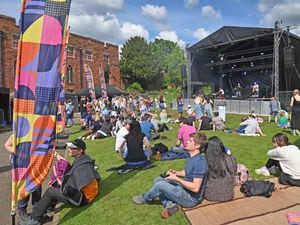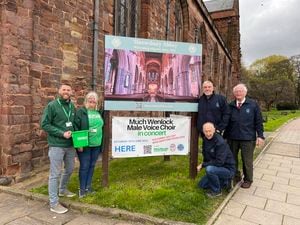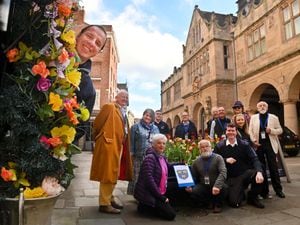Wilfred Owen: Now you can walk in the footsteps of Shropshire war poet
A walk to honour one of Britain’s best loved war poets has been created in the heart of Shrewsbury.
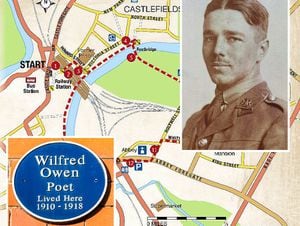
The three-mile war walk takes in places and spaces that were special to World War One poet Wilfred Owen.
Organised by Shropshire Council the War Walk, created by Shropshire historian and author Keith Pybus, starts at the town’s railway station where Wilfred Owen’s father Tom was assistant supervisor of the Joint Railway. It was from here that Wilfred took the train to enlist in the Artists’ Rifles and where he exchanged his last words with his brother Harold.
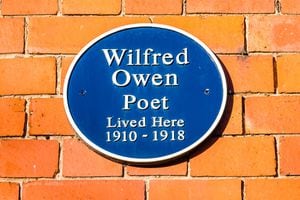
The walk then goes from the station over the Dana footbridge to the prison and then along Howard Street to a steep flight of steps which lead to the river. A short walk comes out at Cherry Orchard where a young Wilfred spent 10 years of his life prior to leaving for the Berlitz School in Bordeaux.
As a nine-year-old he was given a spot in his grandfather’s garden at a house on Underdale Road where he grew potatoes. He wrote he was ‘going to market this afternoon and I might buy some seeds’. Around the corner, in Cleveland Street, is a house where the Owens made their home from 1907-10.
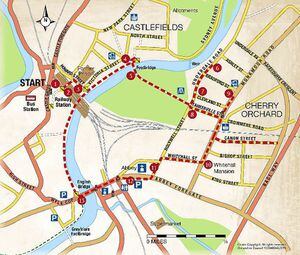
Key to the walk's points of interest:
Station Forecourt
Platform 3 of the railway station
Dana Footbridge
Howard Street steps
River Severn towpath and Castle Walk footbridge
Cherry Orchard
26 Underdale Road
1 Cleveland Place, Cleveland Street
Tankerville Street and 69 Monkmoor Road
Whitehall Mansion
Shrewsbury Abbey gardens with memorial to Wilfred Owen
Shrewsbury Abbey with plaque
Shropshire World War One Group panel to the German prisoner-of-war camp
Wilfred shared the attic room with his brother Harold and worked at a table and chair which he christened his ‘study’. In 1908 he wrote ‘Description of a Railway Station at a Busy Time of Day’. It was around this time that he discovered the joy of poetry while on a holiday in Cheshire.
From their top floor window, the boys had a view over the surrounding meadows to the town.
The family would walk from their home to Uffington, walking along the river to catch the ferry which would take them to church on the opposite side of the River Severn.
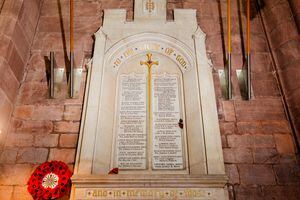
Buttercups grew in the fields and their golden dust adorned the boots of Wilfred’s brother Harold. This image from the Severnside meadows was transposed to the Western Front in ‘Spring Offensive’ penned in 1918.
The Owen family later lived in a three-storey house in Monkmoor Road, which now bears a plaque to mark this and they rented the property from the builder or developer at a cost of £1 a week. They named it Mahim after Tom Owen’s time in India.
Nowadays, Monkmoor Road is a busy route for cars and buses in and out of the town but when the Owen’s lived there there were views of the old racecourse and surrounding fields.
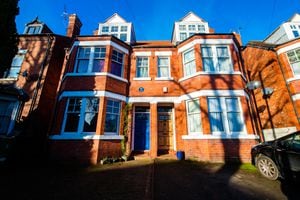
Wilfred was a student at the town’s Technical School when he wrote the first of his first poems which he was to keep.
He wrote hundreds of letters to his mother Susan, and she kept nearly every one – totalling 554. They were kept in no particular order but were tied in bundles with string, wool, ribbon or tape and only discovered in 1956.
Another property in the Monkmoor area with links to the Owens was Wilmot House in Cannon Street. It was here that the family lived from 1897 to 1900 and where Harold was born. The family were the house’s first tenants and the property was named after their home in Oswestry called Plas Wilmot, where Wilfred was born in 1893.
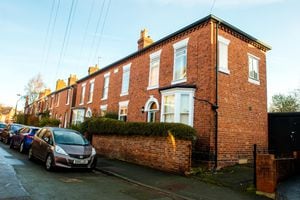
It is possible to see a memorial to Wilfred Owen in the grounds of Shrewsbury Abbey. Installed by the Wilfred Owen Association and created by Paul de Monchaux, the sculpture was designed with reference to his poem Strange Meeting.
There is also a Great War memorial tablet in the Abbey on which the poet’s name appears. It was whilst the bells of the Abbey rang out to announce the Armistice that the Owen family learned of the death of their first born child.
The railway station, which marks the start and end of the walk, featured in his poem The Send Off.
Revered writer who was killed in action
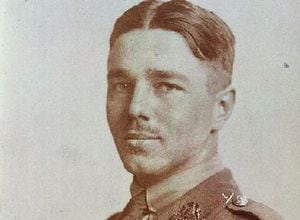
He is one of Shrewsbury’s most famous sons and his work has been revered since his untimely death at the age of just 25.
Now, thanks to the hard work of a local historian, it is possible to follow the footsteps of the country’s greatest war poet and see just how Shrewsbury formed his work.
Wilfred Owen, born in Oswestry but brought up in Shrewsbury, has been celebrated posthumously for his moving and evocative war work.
His poems are taught in schools across the country and the images they conjure up of the horrors of war are not easy to forget.

Teaming up with Shropshire Council, Keith Pybus has created War Walks on the Home Front and Walk Number 9 is entitled: Wilfred Owen and the Tracks to the Trenches.
The fascinating walk takes in the imposing railway station where Wilfred’s father worked and from where he set off on his journey to the battlefields of the Western Front.
Hours of research by Mr Pybus have gone in to creating the walk and snippets of information give those enjoying a gentle stroll a feeling of getting behind the famous man.
His war poetry on the horrors of trenches and gas warfare was heavily influenced by his mentor and celebrated poet Siegfried Sassoon. Among his best-known works, most of which were published posthumously, are “Dulce et Decorum est”, “Insensibility”, “Anthem for Doomed Youth”, “Futility”, “Exposure” and “Strange Meeting”.
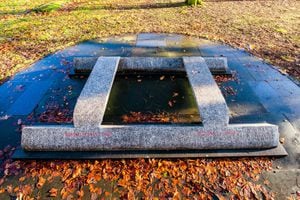
But his time growing up in Shrewsbury formed the basis of his work from his experiences at the railway station to family walks along the banks of the River Severn and pottering in his grandfather’s garden.
On October 21, 1915, he enlisted in the Artists’ Rifles Officers’ Training Corps.
For the next seven months, he trained at Hare Hall Camp in Essex and was then commissioned as a second lieutenant in the Manchester Regiment. During his time at the trenches, he fell into a shell hole and suffered concussion, was blown up by a trench mortar and spent several days unconscious on an embankment lying amongst the remains of one of his fellow officers. Soon afterwards, he was diagnosed as suffering from shell shock and sent to Craiglockhart War Hospital in Edinburgh for treatment where he met Siegfried Sassoon.
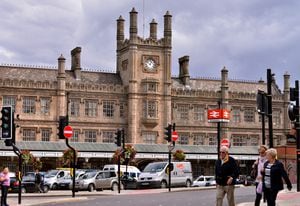
He returned in July 1918 to active service in France and at the end of August was back at the front line. But he was killed in action on November 4 during the crossing of the Sambre-Oise Canal, exactly one week before the signing of the Armistice which ended the war, and was promoted to the rank of Lieutenant the day after his death. His mother received the telegram informing her of his death on Armistice Day.
He is regarded by many as the greatest poet of the First World War, known for his verse about the horrors of trench and gas warfare. He had been writing poetry for some years before the war, himself dating his poetic beginnings to a stay at Broxton by the Hill when he was 10 years old.
His experiences with religion heavily influenced his poetry, notably in poems such as ‘Anthem for Doomed Youth’, in which the ceremony of a funeral is re-enacted not in a church, but on the battlefield itself, and ‘At a Calvary near the Ancre’, which comments on the Crucifixion of Christ. Owen’s experiences in war led him further to challenge his religious beliefs.

